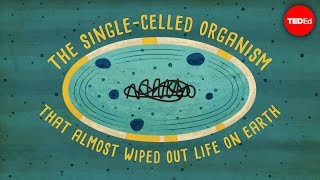(单词翻译:单击)
There's an organism that changed the world.
这是一个改变了世界的生物。
It caused both the first mass extinction in Earth's history and also paved the way for complex life. How?
它导致了地球历史上第一次大规模的灭绝,但也为之后的复杂生命铺平了道路。怎么做到的呢?
By sending the first free oxygen molecules into our atmosphere, and they did all this as single-celled life forms.
它们把第一个自由氧分子送到我们的大气层中,并且它们是以单细胞的生命形态来完成这一切的。
They're cyanobacteria, and the story of these simple organisms that don't even have nuclei or any other organelles
它们就是蓝藻,这些简单的生物没有细胞核和其它任何细胞器,
is a pivotal chapter in the story of life on Earth.
而它们的故事正是地球上生命的故事的一个关键章节。
Earth's atmosphere wasn't always the oxygen-rich mixture we breathe today.
地球的大气层并非一直充满着我们现在呼吸的富氧的混合物。
3.5 billion years ago, the atmosphere was mostly nitrogen, carbon dioxide, and methane.
3.5亿年以前,大气层中的大多是氮气,二氧化碳和甲烷。
Almost all oxygen was locked up in molecules like water, not floating around in the air.
几乎所有的氧气都被锁在像水一样的分子里,并不是在空气中飘着。
The oceans were populated by anaerobic microbes.
海洋被厌氧微生物填充。
Those are simple, unicellular life forms that thrive without oxygen and get energy by scavenging what molecules they find.
它们是在没有氧气的环境中茁壮成长的、以单细胞形式存在的简单生物,它们从找到的被净化的分子中汲取能力。
But somewhere between 2.5 and 3.5 billion years ago,
但在2.5到3.5亿年前,
one of these microbial species, probably floating on the surface of the ocean, evolved a new ability: photosynthesis.
这类微生物群中的一个可能正飘在海洋表面,进化出了一种新的能力:光合作用。
Structures in their cell membrane could harness the energy from sunlight
它们细胞膜中的结构可以利用阳光中的能量,
to turn carbon dioxide and water into oxygen gas and sugars, which they could use for energy.
将二氧化碳和水转化成氧气和糖分,并作为它们的能源。
Those organisms were the ancestors of what we now call cyanobacteria.
这些生物就是我们现在说的蓝藻的祖先。
Their bluish color comes from the blue-green pigments that capture the sunlight they need.
它们的蓝色来源于蓝绿色素,可用于捕捉它们所需要的阳光。
Photosynthesis gave those ancient bacteria a huge advantage over other species.
光合作用使这些古老的细菌比别的物种有更大的优势。

They could now produce their own energy from an almost endless supply of raw ingredients,
它们可以从基本上无尽的原材料中生产它们自己的能源,
so their populations exploded and they started polluting the atmosphere with a new waste product: oxygen.
所以它们的数量剧增并开始向大气中排出一种新型废弃物:氧气。
At first, the trickle of extra oxygen was soaked up by chemical reactions with iron or decomposing cells,
一开始,流出的额外的氧气在和铁的化学反应或细胞分解中被吸收了,
but after a few hundred million years, the cyanobacteria were producing oxygen faster than it could be absorbed,
但在数百万年之后,蓝藻生产氧气的速度比它们吸收的要快,
and the gas started building up in the atmosphere.
气体开始在大气层中聚集。
That was a big problem for the rest of Earth's inhabitants.
这对地球上的其它生物来说是个大问题。
Oxygen-rich air was actually toxic to them. The result?
事实上,富氧的空气对它们来说是有毒的。结果呢?
About 2.5 billion years ago was a mass extinction of virtually all life on Earth, which barely spared the cyanobacteria.
2.5亿年前是一个地球上所有生命的大灭绝,但几乎没有影响到蓝藻。
Geologists call this the Great Oxygenation Event, or even the Oxygen Catastrophe.
地质学家吧这个叫做大氧化事件,甚至氧气大灾难。
That wasn't the only problem.
这不是仅有的问题。
Methane had been acting as a potent greenhouse gas that kept the Earth warm,
甲烷一直是使地球温暖的强效温室气体,
but now, the extra oxygen reacted with methane to form carbon dioxide and water, which don't trap as much heat.
但现在,多余的氧气和甲烷反应产生二氧化碳和水,而不会留住热量。
The thinner atmospheric blanket caused Earth's first, and possibly longest, ice age, the Huronian Glaciation.
越来越薄的大气层导致了地球上第一次,也可能是最长的一次冰期,休伦冰期。
The planet was basically one giant snowball for several hundred million years. Eventually, life adjusted.
星球基本上是一个大雪球并持续了数亿年。最终,生命适应了。
Aerobic organisms, which can use oxygen for energy, started sopping up some of the excess gas in the atmosphere.
需氧生物,可以将氧气作为能源,开始吸收大气中一些多余的气体。
The oxygen concentration rose and fell until eventually it reached the approximate 21% we have today.
氧气的浓度又上又下,直到最终达到了我们今天的浓度,也就是大约21%。
And being able to use the chemical energy in oxygen gave organisms the boost they needed to diversify and evolve more complex forms.
可以利用氧气中的化学能量,给了这些生物它们需要的刺激来实现多元化,并进化出更复杂的形态。
Cyanobacteria had a part to play in that story, too.
蓝藻在这一段故事中也有一个角色。
Hundreds of millions of years ago, some other prehistoric microbe swallowed a cyanobacterium whole in a process called endosymbiosis.
几亿年前,其它一些史前微生物吞噬了蓝藻,这整个过程称为内共生。
In doing so, that microbe acquired its own internal photosynthesis factory.
为了这样做,那个微生物必须拥有自己的内部光合作用工厂。
This was the ancestor of plant cells.
这就是植物细胞的祖先。
And cyanobacteria became chloroplasts, the organelles that carry out photosynthesis today.
蓝藻变成了叶绿体,就是今天那个可以光合作用的细胞器。
Cyanobacteria are still around in almost every environment on Earth: oceans, fresh water, soil, antarctic rocks, sloth fur.
蓝藻还在地球上的几乎每一个环境:海洋、淡水、土地、南极石、树懒毛。
They still pump oxygen into the atmosphere, and they also pull nitrogen out to fertilize the plants they helped create.
它们依然在向大气中泵出氧气,它们也依然将氮气析出,以给它们创造的植物施肥。
We wouldn't recognize life on Earth without them.
如果不是它们,我们不会认识到生命。
But also thanks to them, we almost didn't have life on Earth at all.
但也要谢谢它们,地球上差点就没有生命了。


